Abstract: This article describes the first steps of learning to play the guitar: how to hold it, where to start. First lesson from the PesniGitara portal!
I bet you have at least once heard how beautiful a regular six-string guitar sounds! Yes and, you heard 100%!
Nowadays, there are no problems with this - there are a lot of mp3 recordings, videos... It used to be more difficult: someone heard it in the army, someone on cassette recorders, and of course, in the yard!
The guitar is a very sensitive instrument, but learning to play is not that difficult (at least).
There are two ways to learn to play the guitar:
- Sign up for training courses in your city (music schools, individual lessons etc.)
- Pros: learning from a professional is always very easy, and if you have the desire, you will very quickly master this instrument.
- Cons: you will have to pay money.
- Pros: You can learn to play at any time and at no cost.
- Cons: Good advice, You will have to draw from online/books on guitar self-teaching.
And so, if you have chosen to study with a professional, sign up and go ahead with your studies.
If you do not have the opportunity to learn to play the guitar from a pro in your city, or for some other reason, you want to be self-taught, we hope that our portal will help you!
Let's learn to play the guitar. First steps
First of all, let’s decide what we will need during the learning process:
- Guitar. If it’s not there, then I think it’s not a problem to borrow an instrument from someone you know (there are actually a lot of guitarists).
- Hands. Of course, you can also play with your feet; this depends on the unique structure of your body.
- Head
- Passion and patience. These are the most important factors in learning to play the guitar. If there is no desire and patience, write, it’s lost.
Once you have everything you need (attention: some things must be given to you at birth!), you can begin training!
So, first, let's pick up the guitar. If you are right-handed, then the strings on the fingerboard (the stick on which the strings are stretched (for those who don’t know; D)) should be arranged in this order:
1. e (The thickest. You can try to play “Farewell of the Steam Locomotive” by holding the string on the first fret, give it a good tug (just don’t break it) and move it all the way to the right.)
2. H(B) (Second thickest string, fifth on the list)
3. F (Third thickest. Fourth on the list)
4. D (Fourth thickest. Third on the list)
5. A (Fifth thickest. Second on the list)
6. E (The thinnest.)
Great, now we know the names of the strings and how to hold the guitar correctly (there will be a separate article for left-handers).
Let's move on to a more complex process - taking the first steps.
We hope our article helped you. Best regards, portal!
A guitar fell into your hands, your first thought is what to do with this piece of wood? Firstly learning to play the guitar will take the nth amount of time, a unit directly proportional to the degree of curvature of your hands. Secondly, you need a familiar musician (for example, Chaliapin), or a person with an ear for music, who will be ready to come running at your first call and tune the instrument, because The guitar has the insidious property of going out of tune. It is better to tune it daily, especially if the strings are new and not yet played. If you are left-handed, then immediately ask to re-string the strings in a different order.
Before presenting complex solos to the public, you need to have a good command of chords (half of the solos are just complex chord picking). There are a huge number of them, although for some reason unknown to me, only three are taught in the first lessons. Let us not deviate from the established tradition. Here they are - Am, Dm, E. Each is placed with three fingers and does not present any particular difficulties. On them you can already play “blatnyak” and ditties. Here they are, as it were, “naked”:
For those who don't understand, numbers are scales. For example, the first digit in Am means that there is no need to place your finger on the thickest string (called the bottom because of the pitch of the sound, although it is located at the top), i.e. "empty string" The last number is the best thin string(by analogy with the highest). You need to place your fingers in the chord so as not to touch the neighboring strings, and try to place them closer to the metal partitions; with this placement, the chord sounds better. It will take some time to achieve automaticity when playing chords, usually no more than 3-4 hours of playing. At first, your fingers will hurt (sometimes it even leads to cuts), but then this problem will disappear.
After the 3 chords I suggested, they learn G (320003) and C (332010). Enough simple chords, with them your repertoire will significantly expand. After five chords learned, every beginning guitarist should hear the simple word “bare”. It means that in a chord, the index finger should cover all the strings on a certain fret. For example, let's take the F chord (133211). In it, you need to hold down the entire first fret with your index finger, and use the free three to play the chord itself. It’s better, of course, not to immediately try to play the bar, but to pinch the strings with one finger and play each one, while making sure that the sound is clear. And only then place the remaining fingers.
Actually, that's almost all you need to know to play the guitar.
|
|
The purpose of the tutorial is to help music lovers independently master the initial skills of playing the six string guitar. Hearing development is one of the main tasks at the initial stage of learning music. For this purpose, this tutorial uses the simplest songs, which should not only be played, but also sung along, which will help establish a connection between the player’s hearing and the performance of the piece on the instrument. The guitar is a difficult instrument, and mastering it requires great perseverance, costs large quantity energy and time. This work, designed for the first lessons of a guitarist, does not pretend to fully cover issues related to the process of learning to play the guitar. To do this, it is better to turn to an experienced teacher who can greatly shorten the path to mastering the instrument. However, from the time when an amateur first picks up a guitar, it is necessary to interest him in music and warn him against incorrect playing techniques, creating a basis on which further improvement is already possible. This modest task is pursued by this tutorial.
|
Guitar tutorial Lesson 1. Landing Lesson 2. Positioning of hands. Designations Lesson 3. Metronome Lesson 4. Making sounds on the guitar Lesson 5. Tablatures Lesson 6. Chords Lesson 7. Guitar fight Lesson 8. Music notation Lesson 9. Playing with a pick |
History of the guitar Types of guitars and device Choosing a guitar About strings Guitar tuning Articles Chords for songs Video guitar lessons Video vocal lessons (how to learn to sing) |
|
“Teach me to play the guitar!” This is exactly the expression in lately I hear it very often. I won’t say that I’m a professional in playing this magnificent instrument, but I’m far from a beginner. I have a good amount of experience - 8 years, I tell you, a considerable amount of time. That's why many people, who don't even know if they have hearing, come to me with... Guitar is unique musical instrument. In the hands of a professional, it is capable of producing such a symphony of sounds that will make the listener cry and laugh, rejoice and worry in time with the virtuoso playing. However, not everything in this case is determined by the human factor. Nice guitar is able to express the entire palette of feelings of a musician, a bad instrument... Bossa Nova is an amazing style of Brazilian music that arose from a mixture of jazz and Latin American rhythms. The basic rhythm of bossa nova is based on the rhythm of samba, but harmonically it has much in common with jazz. In the 1950s and 60s, the word bossa was used to mean something new, fresh, unusual, thus words... What do we do when we get together? We drink beer. What else? We sing songs - this will probably be the second most popular answer. Singing without music is not interesting, so a guitar is a must. It’s easy for a person who knows a lot of songs and plays well to become the life of any company. Do you want to make yourself known? All you have to do is learn how to extract beautiful chalk... In this article we will talk about the vulture only string instruments. Sometimes the location of the buttons on a button accordion or accordion is also called the fingerboard. But this is not about him. Of course, it may seem that there is nothing in common between the guitar, balalaika and violin. But no, all laws are the same. The exercises will be slightly different, the positioning of the fingers itself. But the essence is the same. Page... | |
Learn to play the guitar? It's easy! I wrote a lot, edited and composed my own - and I think I succeeded in doing it. I have developed a truly unique training course, after completing which you will learn to play the guitar, even if you currently know absolutely nothing.
Digression: addmy VKontakte profile . There I can give you any advice. I am also available by mobile number +7-964-784-9883, my email [email protected]. Please contact us for any questions. I also provide paid guitar training from scratch (video lessons + consultations), full support.
So. Where to start?
You can also download my own for free guitar course
First, you must have a guitar. I teach you how to play the 6 string acoustic guitar. But this guitar tutorial for beginners Suitable for electric-acoustic guitar, electric guitar, and classical guitar.
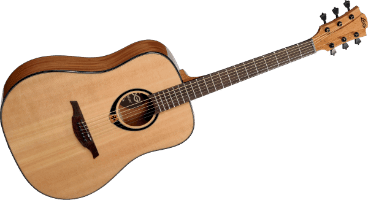
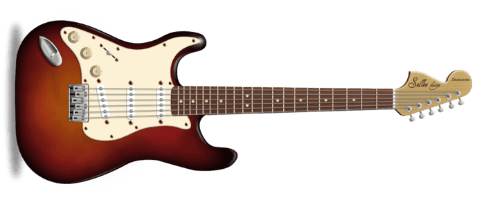
Check out the most frequently asked questions beginners who have not yet started learning - and get a boost of motivation - How long does it take to learn to play the guitar?
Do you have a guitar? Amazing! The next step is tune your guitar- You can’t learn to play an out-of-tune guitar, right?

Attention, the correct answer is how to tune a guitar?
Did you manage to tune your guitar? Okay, let's move on. The guitar is tuned, you can start learning. First we read important information about landing when playing the guitar - landing when playing the guitar .
IT WILL NOT WORK THIS WAY!
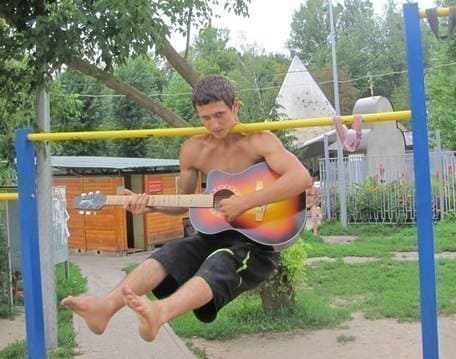
You should also become familiar with the structure of a guitar - what is the name of each element that makes up a guitar? Guitar structure .
Now read the information about the basic concepts that you will often hear - terminology .
Did you manage? Great!
Let's move directly to the design of our training.
It looks something like this:
So, the notes that we will learn first are: Mi, F And Salt. They are located on the first string of the guitar.
Mi– the first open string.
F- first string, first fret.
Salt– first string, third fret.
Note Mi,(note head), located between the fourth and fifth lines of the staff (staff). Note F on the fifth line of the staff (the line crosses the head), the note Salt above the fifth line. Please note that the lines of the staff and the strings of the guitar are not the same thing. There is no symmetry between the arrangement of notes on the guitar fretboard and their arrangement on the staff. You just need to memorize the notes. Notation on the staff - unified system recordings for many musical instruments.
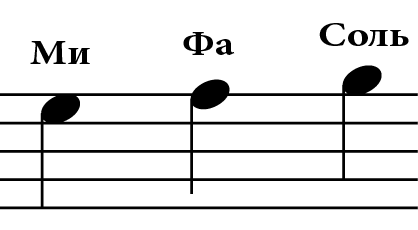
Play the first exercise, which is called “E, Fa, Sol”:
Exercise 1 – “Mi, Fa, Sol”
Start the game index right hand finger (i). Please note that in the left hand, EACH FINGER PLAYS “ITS OWN FRAM”: first finger – 1st fret (note F), third finger – 3rd fret (note Salt). The fingers of the left hand are designated by numbers (1 2 3 4) , and the right letters (p i m a).

Play slowly and take your time. Play it several times. It is better to pronounce (or sing) the names of the notes when playing, this way it will be much easier to remember them. Don’t forget about long and short notes: a hollow note with a stem is a half note (we count “one(s), two(s)”), painted over with a calm – quarter, (we consider “time(s)”). Click on the picture with the exercise to enlarge it and open it in a new window.
Pay attention to your playing technique and hand position. When playing solo melodies on classical guitar, after the note played, finger right hand should, as it were, “crash” into the adjacent string (fix) and remain on it for some time.
Try to press the frets firmly with your left hand fingers, otherwise the sound will be poor quality.
Exercise 2 – “Sun”
The same notes are used in this exercise. The last note Mi– whole, (we count). Please note that you can count each note individually, or you can sum up the count in each measure - “one(s), two(s), three(s), four(s)”. Consider it as you feel comfortable.
Two lines with two dots at the end of the last measure mean repeating the material again from the beginning. This sign is called "Reprise".

Listen to the exercise “Sunshine”
Exercise 3 – “Let’s go on a hike”
Play this exercise the same way as the previous ones.
Attention! Be sure to play ALL the exercises in the course IN ORDER! New notes, as well as terms and techniques are given in the required order.
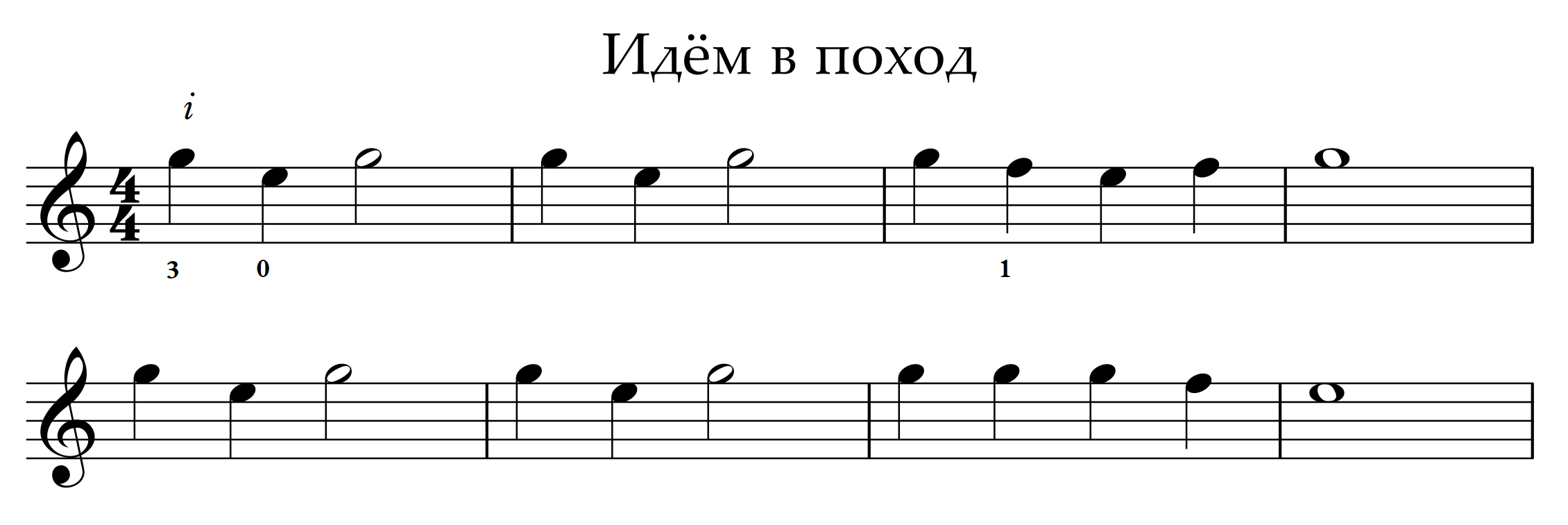
Don't forget about long and short notes, as well as left hand fingering. Remember, each finger plays its own fret.
Listen to the exercise “Let’s go on a hike”:
Exercise 4 – “Note by note.”
Now attention! We will play this exercise with two fingers of the right hand - the index (i) and average (m), alternating them as each new note is played. This is the only correct technique for performing solo melodies on the classical guitar. It's called " apoyando“. At first, of course, you can play the melody with just your index finger. (i), in order to make it easier to remember the notes. Then start playing with two fingers. It doesn't matter which one you start with, the main thing is to change them as you play the notes. Do not forget to fix your fingers on the adjacent (overlying) string.

This course is for anyone who wants to quickly and efficiently learn to play their favorite songs. Both beginners and experienced guitarists will find what they are looking for here!
The course includes detailed analyzes of well-known hit songs, a set of developmental exercises for the fingers of the right and left hands, all the necessary chords, as well as all types of guitar strumming and picking, using which you can play almost any song. Fight “Four”, fight “Troika”, fight “Eight”, two types of fight with muted strings, plus busts: “Four”, “Six” and “Eight”! The course consists of forty HD quality video files available for quick online viewing and downloads. The lessons are taught by music teacher Alexey Zhdanov.

